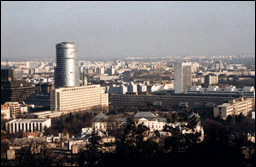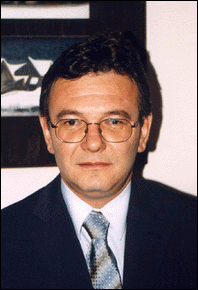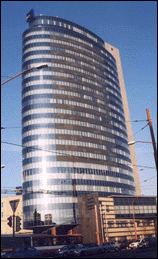 BANKING BANKING |
 The Sun Shines Again The Sun Shines Again |
The banking sector reform that was initiated in 1998 and completed in 2002 is considered to be the most significant success story in Slovakia.

As a properly functioning banking sector in a competitive environment, the strong and flexible foreign-capital banks now control the former state-owned brontosaurs. The stability of this sector provides the most important basis for the sustainable development of the entire country's economy, and after a period of dark and stormy weather the sun is finally rising again over Slovak banking houses.
 The Gloomy Period (1993 - 1998) The Gloomy Period (1993 - 1998) |
Before the elections in 1998, the gloomy forecast of the Slovak-banking sector was one of the main obstacles to the successful completion of the transition of the Slovak economy. More than 40 % of all Slovak gross bank loans that were granted by state-owned banks were falling into the red. Political dependency of all state-controlled banks led to a period of chaos with substandard loans worth almost SKK 200 billion.
Loans provided by state-owned banks without risk evaluation or adequate guarantees were among the main symptoms of Slovak "Crony Capitalism" in the early 1990s. The largest amount of debt that was never paid was accumulated under Vladimir Meciar's leadership. Unsecured loans were provided to both state and private owned enterprises at a non-profitable rate. The bill for these inconsiderate activities had to be paid by all Slovak taxpayers. Therefore, the restructuring and privatization of state-owned banks was the main challenge for the new Cabinet.
 Restructuring and Privatizing (1998 - 2001) Restructuring and Privatizing (1998 - 2001) |
Clearing the financial atmosphere from corruption and constructing a transparent framework required transferring all government stakes in commercial banks into private hands.

However, prior to privatization, a drastic restructuring of the portfolios and assets of banks had to be done. "The Government had to restructure the banking and financial sectors, and there was basically no other choice than getting investors from abroad," thinks Mr. Lodi-Fe, Managing Partner of KPMG. By the end of 1999 the new government had reduced the proportion of substandard loans to 18%.

This was achieved mainly by transferring bad loans worth over SKK 100 billion from the three largest state banks (SLSP, VUB, IRB) to two state hospital banks (Konsolidacna Banka and Slovenska Konsolidacna). The hospital banks were transformed into one restructuring agency, which is now responsible for debt collection. This task however is going to be a long and difficult process with little expectation of profitability. "Since it is not the best portfolio to have, selling part of it can already be considered a great success," explains Ms. Regina Ovesny-Straka Chairman and CEO Slovenska Sporitelna, Slovakia's leading bank sold to Austrian Die Erste Bank.
The Slovak government has issued special "restructuring bonds" totaling approximately SKK 105 billion to cover the costs of the transformation. Despite some criticism that this therapy was too expensive, it is a fact that it allowed the former troubled and state-owned banks to become adequate in capital and ready for privatization.
The banking sector consolidated during this period. The Cabinet managed to reach all of the set targets for the privatization process, consequently 80-90% of the banking sector ended up in foreign hands. "The money market also consolidated due to the disappearance of weaker banks," says the General Manager of Tatrabanka, Mr. Reiner Franz. The most unstable banks have gone bankrupt, like Dopravna banka, Priemyselna banka, AG Banka, SKB, and Devin banka. Others have found strategic partners, such as PKB, Polnobanka, VUB, IRB, Slovenska sporitelna, and Istrobanka. "I think what was done by the government was a success story. Moreover, it was done on a very professional level" adds Mrs. Ovesny-Straka.
 The Present and The Future The Present and The Future |
Slovakia's banking sector should stabilize once the privatization of state-run banks is completed. The banking climate is better; there is a pressure for interest rates to lower.

The National
Bank of Slovakia's Governor, Marian Jusko believes
that "if somebody could compare the situation
three years ago and today, there can be just one
answer: the situation has improved". |
Bank restructuring and privatization is essential for the re-establishment of financial discipline in Slovakia. Austria's Erste Bank took over Slovenska Sporitelna (SLSP), Slovakia's largest bank at the end of 2000. The second-largest bank, VUB was sold to the Italian IntesaBci in 2001 and two smaller state financial institutions, IRB Bank and Istrobanka got respectively sold to the Hungarian OTP Bank and to the Austrian BAWAG.

In the future, only private foreign-owned banks will play an important role on the market. The two strongest banks, Slovenska sporitelna and VUB dominate more than half of the market. Savings in these banks were inherited from the past when no competition existed. The strongest newly established and probably most successful bank in the market is Tatrabanka, which is owned by the Austrian Raiffeisen Zentralbank. This bank also operates a leading Slovak Asset Management company and has the largest Slovak Pension Fund (DDP Pokoj).

"We believe we have a very strong base in order to stay in the lead together with some other foreign banks" thinks Mr. Reiner Franz, General Manager of Tatrabanka.
International and domestic mergers are awaited. In the long run, some experts from the central bank expect only five to six dominant and universal banking houses to remain on the market, along with a couple of specialized banks focused on investment banking, private banking, or mortgage banking. Since 1998, interest rates slid down from their excessively high levels, and a fiercer competition in the market will mean better credit terms for business.
Slovak banks will also have to leave their conservative positions and boost the percentage of corporate and individual loans provided, as the flexible European and American rivals will freshen up the market.
Slovak banks are turning to new e-banking products that require more IT services and solutions. The latter are provided by major international players such as Compaq, IBM, and some fast growing Slovak IT companies such as Gratex International already doing business on the East coast of the USA.

Computer Sciences Corporation, a world leader in consulting and IT services, is among the latter, a successful example of a foreign-capital company headquartered in Slovakia. CSC provides IT services to many large Slovak banks such as VUB, but also to institutions in surrounding countries and even Thailand. "Slovakia itself is a very small market for such a strong company as CSC, but the surrounding geographical areas are interesting," says Mr. Miroslav Mikulcik, General Manager of CSC Slovakia.

Today the Slovak banking sector is perhaps the third strongest in the Central and Eastern European region. "Restructuring of the banking sector in Slovakia is not only considered to be highly positive by the banks but also positive from the point of view of the private and the corporate sectors" says Chief Executive Officer (CEO) of VUB, Mr. Ladislav Vaskovic.
However, despite significant changes in that sector, many more steps need to be taken in other areas. For example, better law enforcement would lead to more incentives and would create a motivating business environment, equal for all companies.
|

